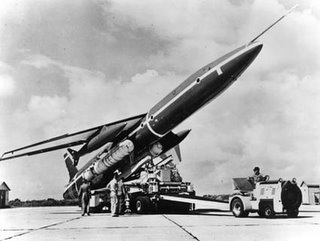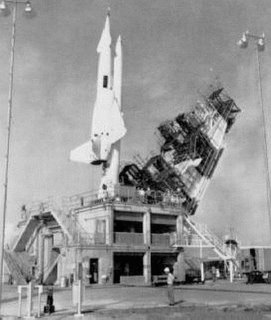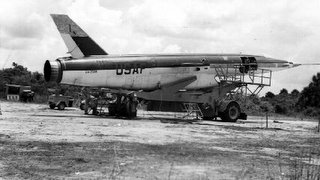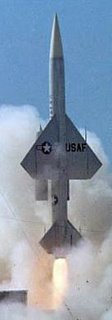Cruise.
This is coolbert:
During the 1950's there WAS a ferment of design in the area of what are best described as "winged" missiles.
Such as the Soviet TU-123. The cruise missile that became the Yastreb in the recon version.
With regard to "winged" missile development, according to Soviet engineers:
"from the very beginning the new tenor of advanced aviation was treated seriously. First of all it can be explained by increased requirements to aviation development in accordance with state-of-the-art level of that times. Certainly there was a rational attitude to application of aircraft capable to operate without pilot saving his life. Absence of the pilot in an air vehicle immediately puts much more severe requirements to such aircraft characteristics as G-force, altitude, vibration, temperature and some others."
[the above is obviously a poor translation from the Russian. Was found on an English language web site for the Tupelov company. What is being said is that without the consideration of having a pilot onboard the "aircraft", a lot of design factors come into play that make for a better and more effective airframe.]
It seems that there was a lot of interest by the military services in this sort of "winged" missile. A lot of projects were started in the U.S. with design in mind of an intercontinental missile capable of delivering a nuclear warhead to the Soviet Union. This was one way to go, as the ICBM [intercontinental ballistic missile] was not yet developed to the extent that it needed to be.
A number of American "winged" missiles were developed and deployed in the era after the end of World War Two [WW2]. With a whole range of successes and failures.
Among the missiles out there were:
1. Snark.

A subsonic cruise missile that resembled a pilotless aircraft in almost exact detail. [well, that is what it was, wasn't it, a pilotless aircraft.]
2. Navajo.

A supersonic cruise missile that resembled more a conventional missile than it did an unmanned aircraft.
3. Regulus.

A cruise missile designed to be launched from the back of a submarine. The submarine would surface, a pod on top of the sub would open, the missile would emerge, be prepped, and then fired.
4. BOMARC.

A anti-aircraft cruise missile. Almost exactly an unmanned aircraft designed for long range intercept of incoming attacking Soviet bombers. Could engage at long range and high altitude intruder Soviet aircraft. Was capable of carrying a conventional OR nuclear payload.
Almost all these weapons systems can be looked upon as more or less boondoggles. Cost a lot of money, and were deployed for only a short time in limited numbers. The Snark for instance, was deployed for ONLY ONE MONTH AND THEN THE SYSTEM WAS TERMINATED.
Even after the advent of the ICBM, these "winged" missiles were still considered to be useful. The Regulus and the BOMARC found themselves being used as target drones for live fire missions. This WAS a good way to get rid of unneeded and unnecessary inventory.
One "winged" missile seems to be a success over the long term however. This is the Teledyne Ryan Q-2/KDA/xQM-34/BGM-34 Firebee.

Used purportedly in unmanned recon missions over China and Vietnam during the 1960's. It was felt that an unmanned aircraft was less intrusive and less objectionable to the communist governments. Whether this was so or not is debatable.
I believe the consensus is that these drone "aircraft" produced results that were not spectacular, but steady and useful, and did so over a long time [a period of decades].
Did not produce results when needed during the lead-up to the abortive and unsuccessful Son Tay raid [U.S. commando unit attempting to free American prisoners of war being held by the forces of the communist north.] I recall that the prisoner-of-war camp at Son Tay in North Vietnam had SEVEN unmanned recon drones sent for flyovers prior to the U.S. commando raid. These drones were on photo missions. And in ALL SEVEN missions, almost nothing of value was obtained. Photos of the horizon were about ALL that was gotten out of the SEVEN missions. This can only be categorized as a tremendous failure!!
Probably in all likelihood the "winged" missiles of the day just were pushing the envelope with regard to design and control systems to be successful. They were superseded by more advanced ICBM designs. Micro-miniature electronics and computerized onboard controls just did not exist at the time to allow for effective "aircraft" to be built. Several decades had to pass before the smaller and effective modern cruise missiles came on line. As is now.
coolbert.

0 Comments:
Post a Comment
Subscribe to Post Comments [Atom]
<< Home